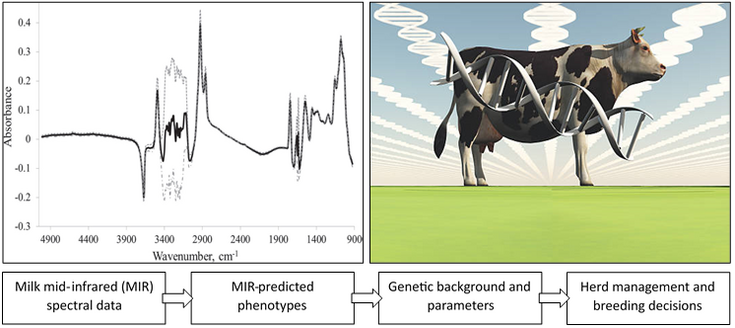Mid-infrared predicted traits for energy balance and their genetic background in dairy cows
SUPERVISOR: Johann SÖLKNER
PROJECT ASSIGNED TO: Stefan GRUBER
Feed efficiency is receiving increased emphasis in dairy cattle breeding. For evaluation and incorporation of feed efficiency in national breeding objectives, reliable phenotypes on direct or auxiliary traits are necessary. To evaluate feed efficiency certain indicators can be considered, including energy balance and associated traits. Mid-infrared (MIR) spectra data is routinely used to determine major milk components in milk recording schemes, but also applied to evaluate biochemical composition of milk and interconnected health and metabolic status of dairy cows. That harbors the capacity of MIR spectroscopy to also predict traits related to energy balance. These MIR-predicted phenotypes can be applied to improve metabolic health of dairy herds through herd management and decision support, or to provide large-scale phenotypes in breeding merit estimations. Though, before MIR-predicted phenotypes can be reliably established in development of breeding merits, information on genetic correlations and biological background is necessary.
Hence, the first aim of the doctoral thesis is to develop spectrometric equations for the prediction of energy balance and related traits, based on MIR spectral data in lactating dairy cows. Considered traits encompass energy intake, feed intake, body weight, body condition score and associated blood metabolites. Prediction models for target traits are developed by implementation of various machine learning algorithms, such as PLS regression, artificial neural networks, or ridge regression. In addition, spectrometric equations are validated with regard to accurateness and robustness using various data sets. Moreover, it is aimed to utilize MIR-predicted phenotypes for genetic analyses in order to assess their genetic background and parameters. Initially, genetic analysis is conducted using an animal model on a pedigree basis to estimate heritability and genetic correlations for relevant traits. Subsequently, a genome-wide association study (GWAS) is performed to potentially identify regions on the genome being involved with certain traits and to derive genetic parameters.
Results of this study could thus potentially be beneficial to augment breeding decisions and herd management on farm-level in Austria. This doctoral project is carried out in the framework of the project Breed4Green on the overall topic “Direct and indirect traits for feed efficiency and greenhouse gas emissions for breeding and herd management”.

